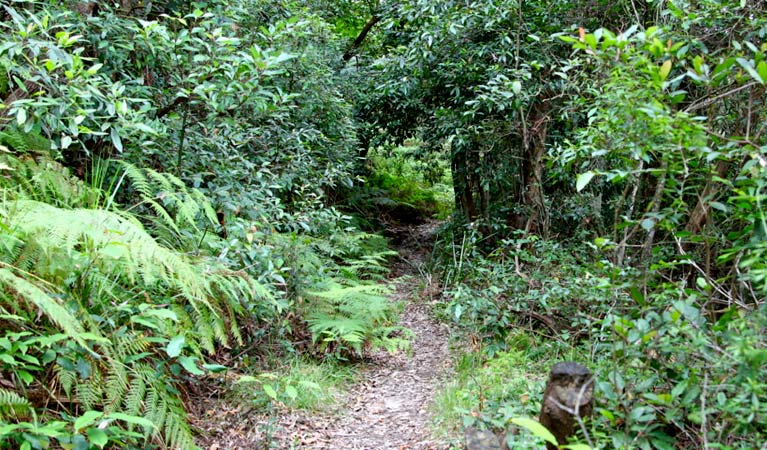Seaforth Oval to Natural Bridge track
Garigal National Park
Overview
This challenging walk includes Timber Getters track, the Bay track and Bluff trail near Forestville. Beautiful nature, historic sites and spectacular views await you.
- Distance
- 3.4km one-way
- Time suggested
- 1hr 30min - 2hrs
- Grade
- Grade 3
- Entry fees
-
Park entry fees apply at Davidson Park only
- What to
bring - Sunscreen, hat, drinking water
- Please note
- Remember to take your binoculars if you want to birdwatch.
Seaforth Oval to Natural Bridge track is a scenic walk that’s full of history, but that’s not all that’ll get your pulse racing. The descent into Bantry Bay via the Timber Getters track is difficult and steep. About halfway down it crosses the historic Old Bullock track, which was constructed in 1856 to haul sawn timber from sawmills in ‘The Big Forest’ owned by James Harris French (after whom Frenchs Forest was named) to the shores of Bantry Bay.
At the end of the Timber Getters track, you’ll reach a rest area with toilets, once the site of the Bantry Bay ‘Pleasure Gardens' dance hall. From 1915 until 1973 however, it was part of the site of the Bantry Bay Explosives Magazine complex, which is what you’ll see today.
The Bay track follows the line of the waterfront and eventually winds its way up to the base of ‘The Bluff’. The climb is tough going, however you’ll be rewarded with spectacular views of Middle Harbour when you reach the top. From ‘The Bluff’, you’ll follow The Bluff track until you reach Natural Bridge track. For a longer walk, take Natural Bridge track to Davidson Park.
Map
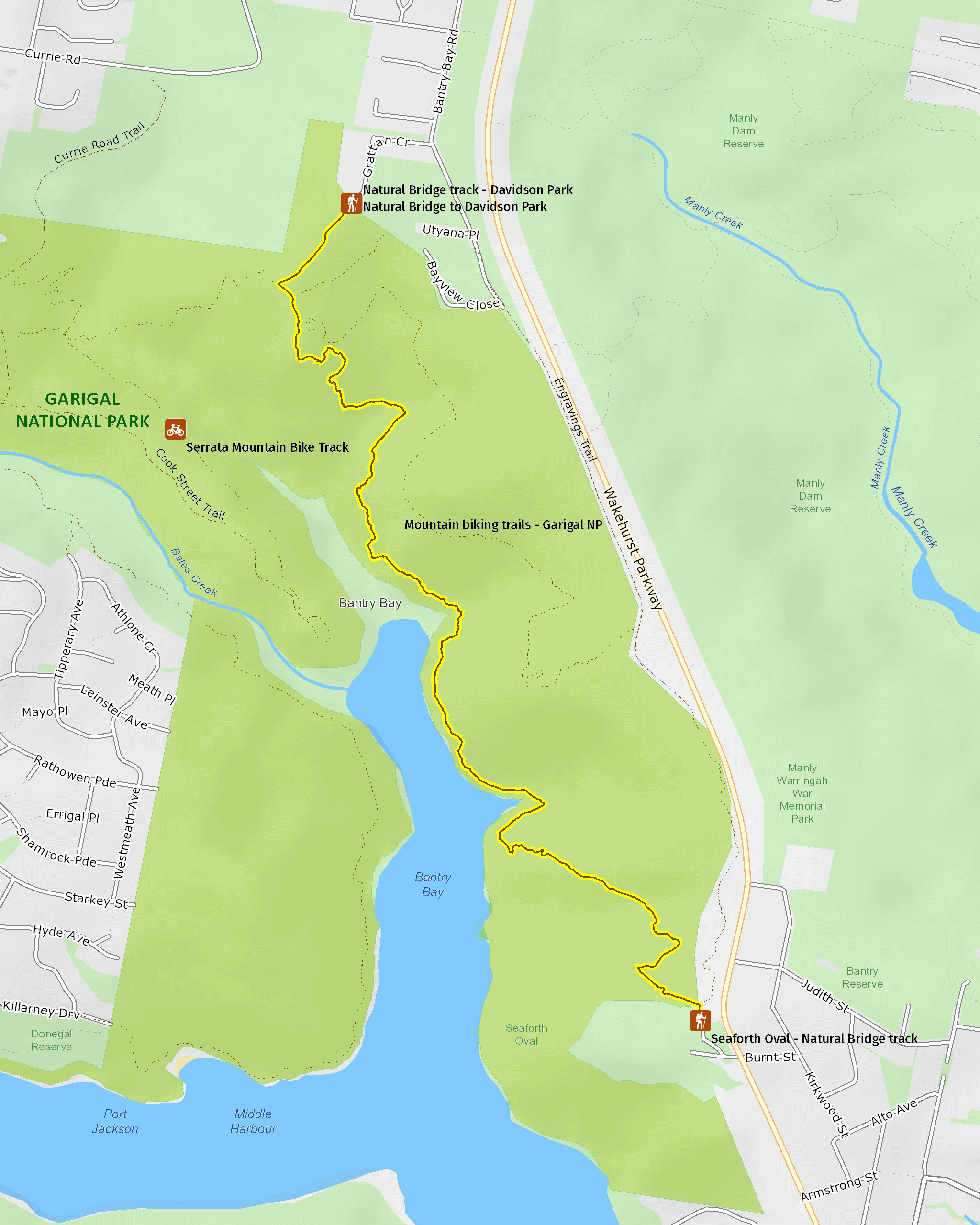
Map legend

Local alerts
For the latest updates on fires, closures and other alerts in this area, see https://www.nationalparks.nsw.gov.au/things-to-do/walking-tracks/seaforth-oval-to-natural-bridge-track/local-alerts
General enquiries
- National Parks Contact Centre
- 7am to 7pm daily
- 1300 072 757 (13000 PARKS) for the cost of a local call within Australia excluding mobiles
- parks.info@environment.nsw.gov.au
Park info
- in Garigal National Park in the Sydney and surrounds region
Garigal National Park is open 6am to 6.30pm (8pm during daylight savings) but may have to close at times due to poor weather or fire danger.
-
Park entry fees:
$8 per vehicle per day applies only at Davidson Park only. Day passes are available from on-park pay machines that accept coins and credit cards, and you can also pay for your visit via the Park’nPay app.
Bus: $4.40 per adult, $2.20 per child (per day).
Daily entry fee exemption for teachers and educational supervisors (1 adult per 10 children) applies only for organised and pre-arranged group bookings.
Buy annual pass.
Visitor info
All the practical information you need to know about Seaforth Oval to Natural Bridge track.
Track grading
Features of this track
Distance
3.4km one-way
Time
1hr 30min - 2hrs
Quality of markings
Clearly sign posted
Experience required
Some bushwalking experience recommended
Gradient
Short steep hills
Steps
Many steps
Quality of path
Formed track
Getting there and parking
This walk starts at Seaforth Oval, Wakehurst Parkway, Seaforth. To get there:
- Make your way to Warringah Road, Frenchs Forest
- At Blackpitt Reserve head south into Wakehurst Parkway
- Turn right into Seaforth Oval (opposite Burnt Street)
It can be a busy place on the weekend, so parking might be limited.
Parking
Parking is available at Seaforth Oval, Wakehurst Parkway, Seaforth, and on Gratton Crescent if you start the walk at Forestville.
Best times to visit
There are lots of great things waiting for you in Garigal National Park. Here are some of the highlights.
Spring
Spot wildflowers turning the undergrowth into a painter's palette along the Cascades trail during late winter and early spring.
Summer
Davidson Park is a popular place for a family picnic or barbecue, so pack up the kids and a tasty lunch to enjoy some time in the great outdoors.
Weather, temperature and rainfall
Summer temperature
Average
18°C and 26°C
Highest recorded
44°C
Winter temperature
Average
10°C and 16°C
Lowest recorded
-1.7°C
Rainfall
Wettest month
March
Driest month
September
The area’s highest recorded rainfall in one day
290mm
Maps and downloads
Prohibited
Cycling
Cycling is not permitted on this track.
Gathering firewood
Gathering firewood and the use of heat beads is not permitted.
Pets
Pets and domestic animals (other than certified assistance animals) are not permitted. Find out which regional parks allow dog walking and see the pets in parks policy for more information.
Smoking
NSW national parks are no smoking areas.
Learn more
Seaforth Oval to Natural Bridge track is in Garigal National Park. Here are just some of the reasons why this park is special:
Outdoor action
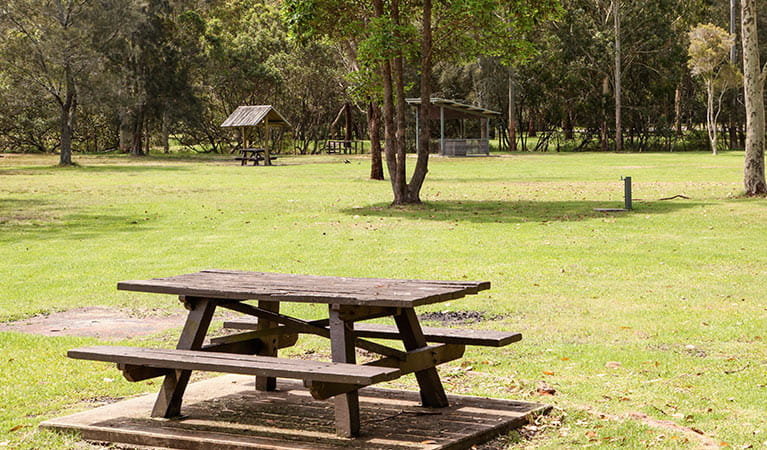
There are countless ways to pass the time in Garigal. Explore the park's trails and tracks on horseback, mountain bike or on foot. If you enjoy water activities, launch your canoe or boat from the ramp at Davidson Park or drop a line in one of the great fishing spots throughout the park, like Middle Harbour, where you can catch flathead, flounder, mullet and bream.
- Cascades trail Cascades trail is ideal for walking, horseriding and mountain biking in Garigal National Park. A medium difficulty walk or ride along a fire trail, it traverses Middle Harbour creek.
- Davidson Park picnic area and boat ramp If you're looking for something to do in Sydney, Davidson Park is a pretty harbourside park with boating and canoeing access, just a short drive from the Sydney CBD.
- Natural Bridge track to Davidson Park This challenging walking track winds through Garigal National Park, and features impressive sandstone rock formations and spectacular water views.
Rich Aboriginal heritage
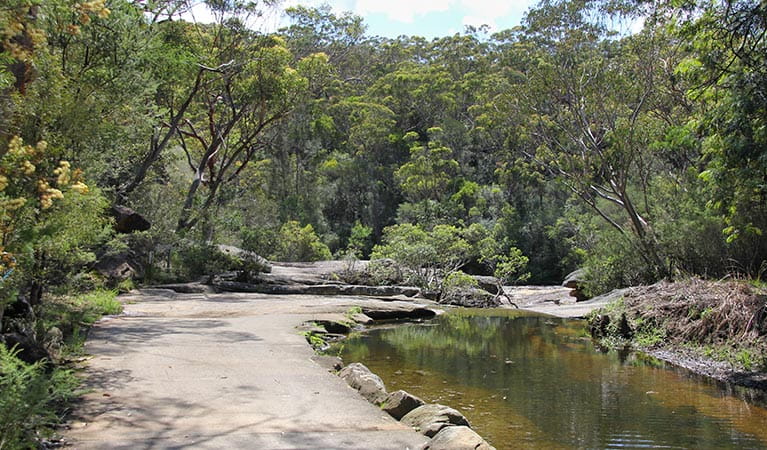
Aboriginal people have been custodians of the land in Garigal National Park for thousands of years and this connection and legacy is evident throughout the park. Garigal has extensive Aboriginal art sites, with over 100 Aboriginal sites recorded to date, including cave art, rock engravings, shelters, middens and grinding grooves.
- Hawkesbury to harbour walk: Stage 3 Join this great 7hr, 14km guided walk and explore Garigal National Park in northern Sydney. It's the third walk in a series of 5 walks.
- Hawkesbury to harbour walk: Stage 4 Explore the sights of Garigal National Park by joining this 7.5hr, 16km guided walk on the Sydney's lower north shore.
- Hawkesbury to harbour walk: Stage 5 Explore the sights of Garigal and Sydney Harbour national parks on this 11km guided tour. You’ll walk for 5.5hrs from the Spit Bridge to Manly, taking in some of Sydney’s most iconic coastline.
Wartime stories
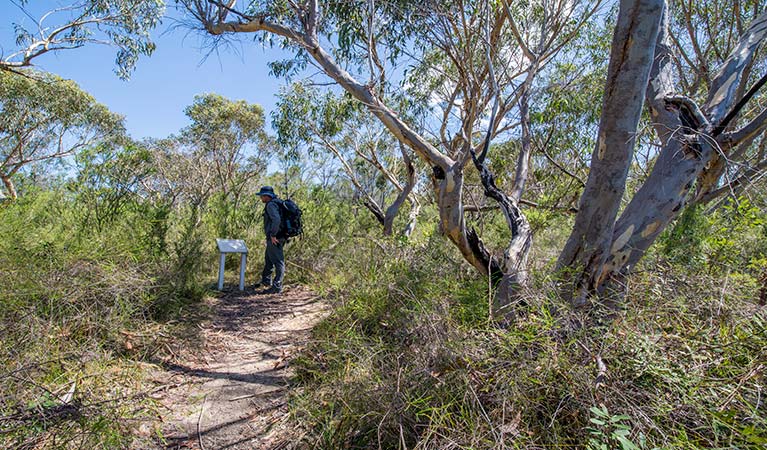
There are many places of historical interest in the park, such as Bungaroo and the former Bantry Bay Explosives Magazine complex. Both sites played a key role in the early establishment of Sydney and are important reminders of our history since colonisation. Enjoy a walk to Bantry Bay, where you'll see a collection of historically important buildings surrounded by stunning foreshore and bushland views.
- Hawkesbury to harbour walk: Stage 3 Join this great 7hr, 14km guided walk and explore Garigal National Park in northern Sydney. It's the third walk in a series of 5 walks.
- Hawkesbury to harbour walk: Stage 4 Explore the sights of Garigal National Park by joining this 7.5hr, 16km guided walk on the Sydney's lower north shore.
- Hawkesbury to harbour walk: Stage 5 Explore the sights of Garigal and Sydney Harbour national parks on this 11km guided tour. You’ll walk for 5.5hrs from the Spit Bridge to Manly, taking in some of Sydney’s most iconic coastline.
- Pipeline and Bungaroo tracks to Stepping Stones Crossing This short steep walk is one of the most beautiful on Sydney’s upper north shore. Beginning at St Ives, it leads you through Garigal National Park to Middle Harbour creek.
Wildlife haven
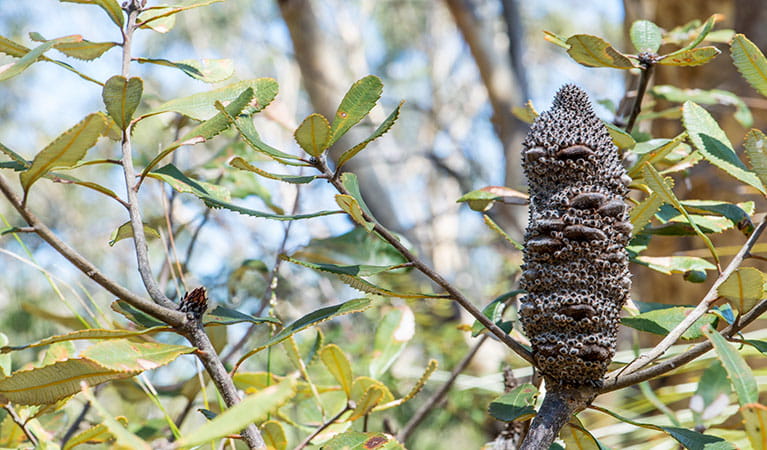
Garigal is part of an important wildlife corridor that spans all the way from Sydney Harbour to the national parks of the Blue Mountains. It's the natural habitat for a number of threatened native animal species, such as tiger quolls, broad-headed snakes and red-crowned toadlets, so keep your eyes peeled. If you see a hole in the ground it may be that of the endangered southern brown bandicoot.
- Cascades trail Cascades trail is ideal for walking, horseriding and mountain biking in Garigal National Park. A medium difficulty walk or ride along a fire trail, it traverses Middle Harbour creek.
- Hawkesbury to harbour walk: Stage 3 Join this great 7hr, 14km guided walk and explore Garigal National Park in northern Sydney. It's the third walk in a series of 5 walks.
- Hawkesbury to harbour walk: Stage 4 Explore the sights of Garigal National Park by joining this 7.5hr, 16km guided walk on the Sydney's lower north shore.
- Hawkesbury to harbour walk: Stage 5 Explore the sights of Garigal and Sydney Harbour national parks on this 11km guided tour. You’ll walk for 5.5hrs from the Spit Bridge to Manly, taking in some of Sydney’s most iconic coastline.
- Stepping Stone Crossing to Cascades trail Located in Garigal National Park, Stepping Stone Crossing to Cascades trail is an easy walk that you can enjoy by walking, horse riding or mountain biking.
Plants and animals protected in this park
Animals
-
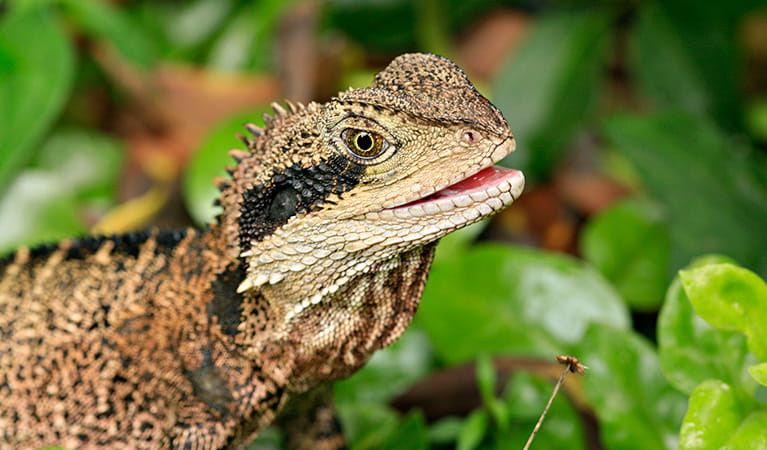
Eastern water dragon (Intellagama lesueurii lesueurii)
The eastern water dragon is a subaquatic lizard found in healthy waterways along eastern NSW, from Nowra to halfway up the Cape York Pensinsula. It’s believed to be one of the oldest of Australian reptiles, remaining virtually unchanged for over 20 million years.
Plants
-
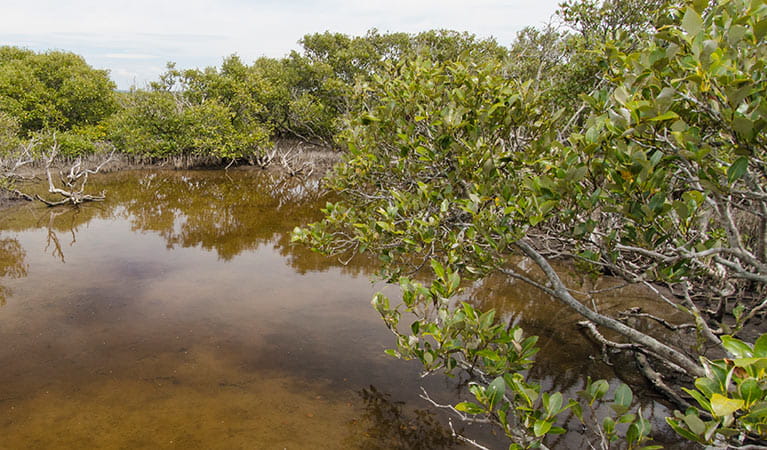
Grey mangrove (Avicennia marina)
Grey mangrove is the most common and widespread mangrove found within intertidal zones across Australia, and throughout the world. Growing to a height of 3-10m, they thrive best in estuaries with a mix of fresh and salt water. They excrete excess salt through their long thick leaves, and absorb oxygen through their aerial root system.
-
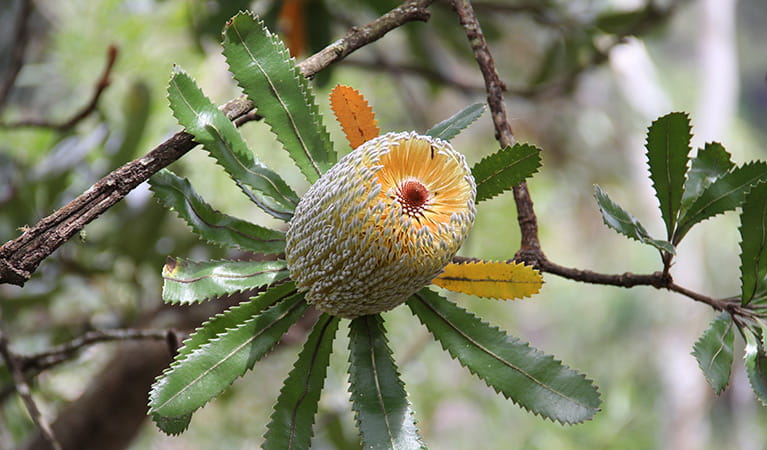
Old man banksia (Banksia serrata)
Hardy Australian native plants, old man banksias can be found along the coast, and in the dry sclerophyll forests and sandstone mountain ranges of NSW. With roughened bark and gnarled limbs, they produce a distinctive cylindrical yellow-green banksia flower which blossoms from summer to early autumn.
-

Grass tree (Xanthorrea spp.)
An iconic part of the Australian landscape, the grass tree is widespread across eastern NSW. These Australian native plants have a thick fire-blackened trunk and long spiked leaves. They are found in heath and open forests across eastern NSW. The grass tree grows 1-5m in height and produces striking white-flowered spikes which grow up to 1m long.
-
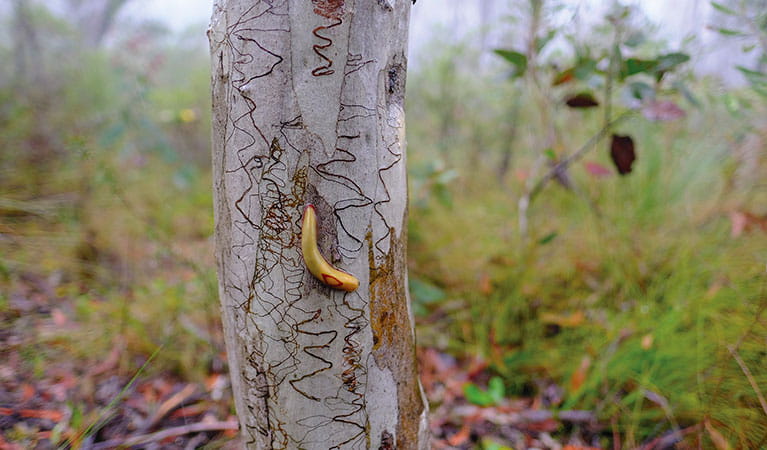
Scribbly gum (Eucalyptus haemastoma)
Easily identifiable Australian native plants, scribbly gum trees are found throughout NSW coastal plains and hills in the Sydney region. The most distinctive features of this eucalypt are the ‘scribbles’ made by moth larva as it tunnels between the layers of bark.

